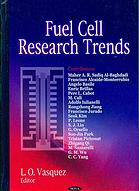
Language: English
ISBN: 1600216692
Paperback: 486 pages
Description: A fuel cell is an electrochemical energy conversion device. It produces electricity from external supplies of fuel (on the anode side) and oxidant (on the cathode side). These react in the presence of an electrolyte. Generally, the reactants flow in and reaction products flow out while the electrolyte remains in the cell. Fuel cells can operate virtually continuously as long as the necessary flows are maintained. Fuel cells differ from batteries in that they consume reactants, which must be replenished, while batteries store electrical energy chemically in a closed system. Additionally, while the electrodes within a battery react and change as a battery is charged or discharged, a fuel cell's electrodes are catalytic and relatively stable. Fuel cells are very useful as power sources in remote locations, such as spacecraft, remote weather stations, large parks, rural locations, and in certain military applications. A fuel cell system running on hydrogen can be compact, lightweight and has no major moving parts. Because fuel cells have no moving parts, and do not involve combustion, in ideal conditions they can achieve up to 99.9999% reliability. This equates to less than one minute of down time in a six year period. This book presents new leading-edge research in the field.
Table of Contents:
Preface
Expert Commentary
- Qualification of Fuel Cell Membrane Electrode Assemblies; pp. 3-6
(Zhigang Qi, Plug Power Inc.)
Research and Review Studies
Chapter 1 - Power and Energy Efficiency Analysis of Direct Methanol Fuel Cell (DMFC) from Single Cell, Fuel Cell Stack to DMFC System; pp. 9-70
(Rongzhong Jiang, Sensors and Electron Devices Directorate, U.S. Army Research Laboratory, Adelphi, MD)
Chapter 2 - Experimental Activity on a Large SOFC Generator;
pp. 71-134
(M. Santarelli, P. Leone, M. Cali, G. Orsello, Dipartimento di Energetica, Politecnico di Torino, Torino, Italy)
Chapter 3 - Alternative Sulfonated Polymers to Nafion for PEM Fuel Cell; pp. 135-160
(Angelo Basile, Adolfo Iulianelli, Institute on Membrane Technology, Univ. of Calabria, Rende, Italy)
Chapter 4 - A Potential Alternative in the Electric Utility;
pp. 161-209
(Francisco Jurado, Univ. of Jaen, Dept. of Electrical Engineering, EPS Linares, Spain)
Chapter 5 - Microfabrication Techniques: Useful Tools for Miniaturizing Fuel Cells; pp. 211-245
(Tristan Pichonat, Microsystems Group, Cite Scientifique, Villeneuve D'Ascq, Cedex, France)
Chapter 6 - Technical H2 Electrodes for Low Temperature Fuel Cells; pp. 247-272
(Francisco Alcaide-Monterrubio, Centre for Electrochemical Technologies, San Sebastian, Spain, Pere L. Cabot, Enric Brillas, Laboratori d'Electroquimica dels Materials i del Medi Ambient, Dept. de Quimica Fisica, Univ. de Barcelona, Barcelona, Spain)
Chapter 7 - PEM Fuel Cell Modeling; pp. 273-379
(Maher A. R. Sadiq Al-Baghdadi, Dept. of Mechanical Engineering, International Technological Univ., London, UK)
Chapter 8 - Surface Functionalization of Carbon Catalyst-Support for PEM Fuel Cells: A Review; pp. 381-410
(Zhigang Qi, Plug Power Inc., Latham, NY)
Chapter 9 - A Study on the Role of Carbon Support Materials for Fuel-Cell Catalysts; pp. 411-443
(Seok Kim, Advanced Material Division, Korea Research Institute of Chemical Technology, Daejeon, South Korea, Soo-Jin Park, Dept. of Chemistry, Inha Univ., Incheon, South Korea)
Chapter 10 - Developments of Alkaline Solid Polymer Electrolyte Membrances based on Polyvinyl Alcohol and their applications in Electrochemical Cells; pp. 445-471
(G.M. Wu, S. J. Lin, Institute of Electro-Optical Engineering, Dept. of Chemical and Materials Engineering, Chang Gung Univ., Taoyuan, Taiwan, C. C. Wang, Dept. of Chemical Engineering, Ming Chi Univ. of Technology, Taipei, Taiwan)
Index
http://www.amazon.com/Fuel-Cell-Research-Trends-Vasquez/dp/1600216692
'Book & Memo > Others' 카테고리의 다른 글
| 32/64-bit 80x86 Assembly Language Architecture (0) | 2009.08.05 |
|---|---|
| The Fabulous Fibonacci Numbers (0) | 2009.06.21 |
| Digital Television (0) | 2009.05.23 |
| Video Compression and Communications (0) | 2009.05.23 |
| Professional iPhone and iPod touch Programming: Building ... (0) | 2009.03.06 |